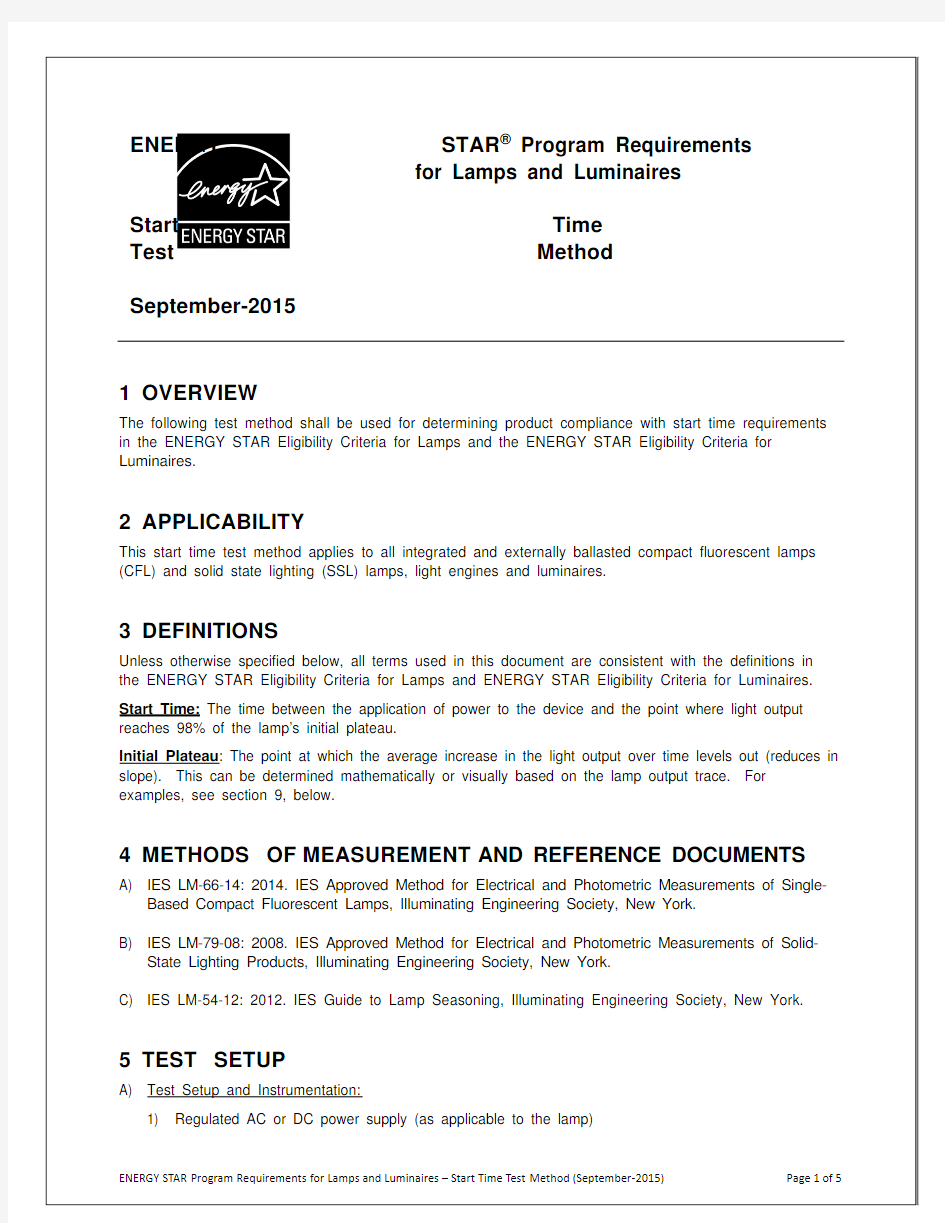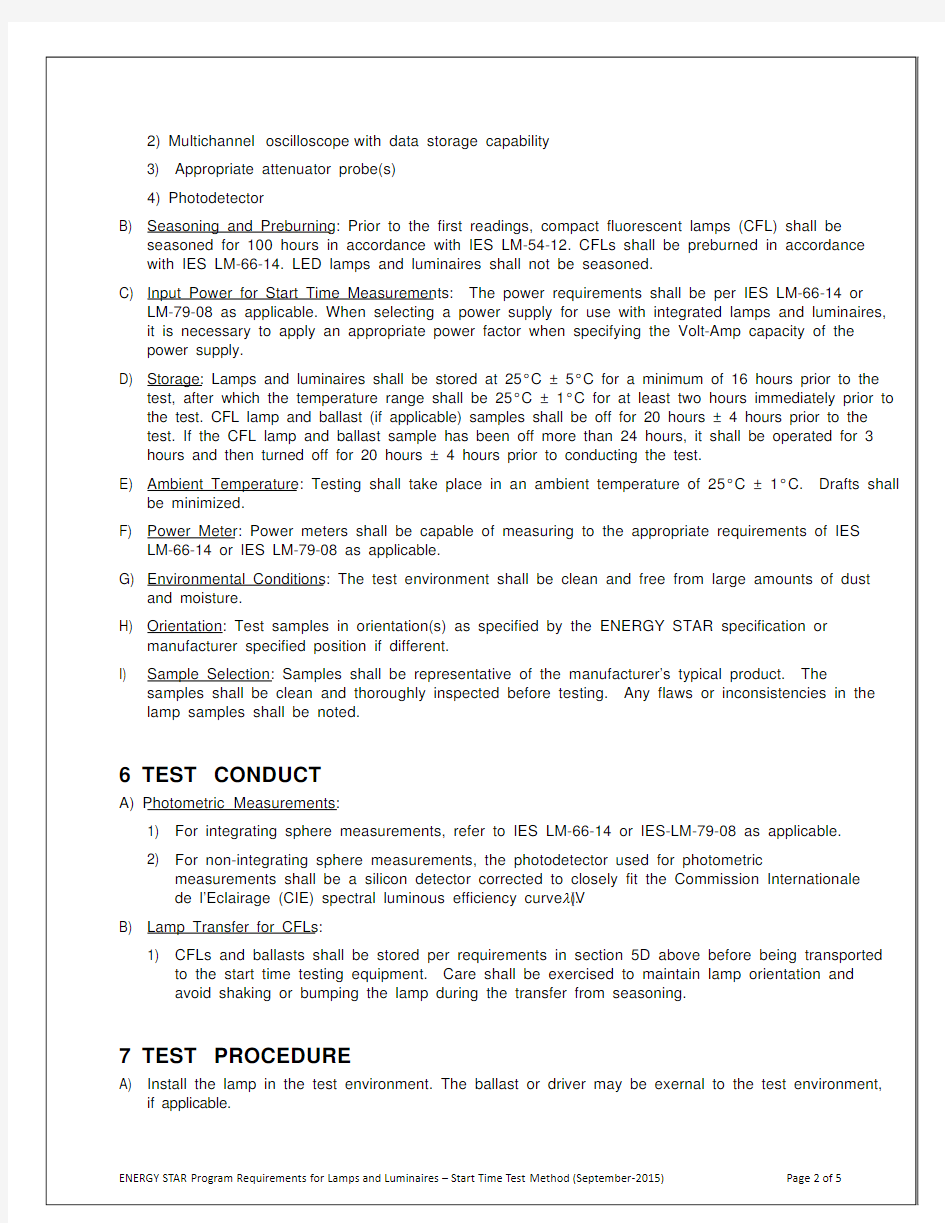

ENERGY
STAR? Program Requirements
for Lamps and Luminaires
Time Start
Method Test
September-2015
1 OVERVIEW
The following test method shall be used for determining product compliance with start time requirements
in the ENERGY STAR Eligibility Criteria for Lamps and the ENERGY STAR Eligibility Criteria for
Luminaires.
2 APPLICABILITY
This start time test method applies to all integrated and externally ballasted compact fluorescent lamps
(CFL) and solid state lighting (SSL) lamps, light engines and luminaires.
3 DEFINITIONS
Unless otherwise specified below, all terms used in this document are consistent with the definitions in
the ENERGY STAR Eligibility Criteria for Lamps and ENERGY STAR Eligibility Criteria for Luminaires.
Start Time: The time between the application of power to the device and the point where light output
reaches 98% of the lamp’s initial plateau.
Initial Plateau: The point at which the average increase in the light output over time levels out (reduces in
slope). This can be determined mathematically or visually based on the lamp output trace. For
examples, see section 9, below.
4 METHODS OF MEASUREMENT AND REFERENCE DOCUMENTS
A) IES LM-66-14: 2014. IES Approved Method for Electrical and Photometric Measurements of Single-
Based Compact Fluorescent Lamps, Illuminating Engineering Society, New York.
B) IES LM-79-08: 2008. IES Approved Method for Electrical and Photometric Measurements of Solid-
State Lighting Products, Illuminating Engineering Society, New York.
C) IES LM-54-12: 2012. IES Guide to Lamp Seasoning, Illuminating Engineering Society, New York.
5 TEST SETUP
A) Test Setup and Instrumentation:
1) Regulated AC or DC power supply (as applicable to the lamp)
2) Multichannel oscilloscope with data storage capability
3) Appropriate attenuator probe(s)
4) Photodetector
B) Seasoning and Preburning: Prior to the first readings, compact fluorescent lamps (CFL) shall be
seasoned for 100 hours in accordance with IES LM-54-12. CFLs shall be preburned in accordance with IES LM-66-14. LED lamps and luminaires shall not be seasoned.
C) Input Power for Start Time Measurements: The power requirements shall be per IES LM-66-14 or
LM-79-08 as applicable. When selecting a power supply for use with integrated lamps and luminaires, it is necessary to apply an appropriate power factor when specifying the Volt-Amp capacity of the power supply.
D) Storage: Lamps and luminaires shall be stored at 25°C ± 5°C for a minimum of 16 hours prior to the
test, after which the temperature range shall be 25°C ± 1°C for at least two hours immediately prior to the test. CFL lamp and ballast (if applicable) samples shall be off for 20 hours ± 4 hours prior to the test. If the CFL lamp and ballast sample has been off more than 24 hours, it shall be operated for 3 hours and then turned off for 20 hours ± 4 hours prior to conducting the test.
E) Ambient Temperature: Testing shall take place in an ambient temperature of 25°C ± 1°C. Drafts shall
be minimized.
F) Power Meter: Power meters shall be capable of measuring to the appropriate requirements of IES
LM-66-14 or IES LM-79-08 as applicable.
G) Environmental Conditions: The test environment shall be clean and free from large amounts of dust
and moisture.
H) Orientation: Test samples in orientation(s) as specified by the ENERGY STAR specification or
manufacturer specified position if different.
I) Sample Selection: Samples shall be representative of the manufacturer’s typical product. The
samples shall be clean and thoroughly inspected before testing. Any flaws or inconsistencies in the lamp samples shall be noted.
6 TEST CONDUCT
A) Photometric Measurements:
1) For integrating sphere measurements, refer to IES LM-66-14 or IES-LM-79-08 as applicable.
2) For non-integrating sphere measurements, the photodetector used for photometric
measurements shall be a silicon detector corrected to closely fit the Commission Internationale
de l’Eclairage (CIE) spectral luminous efficiency curve (V?).
B) Lamp Transfer for CFLs:
1) CFLs and ballasts shall be stored per requirements in section 5D above before being transported
to the start time testing equipment. Care shall be exercised to maintain lamp orientation and
avoid shaking or bumping the lamp during the transfer from seasoning.
7 TEST PROCEDURE
A) Install the lamp in the test environment. The ballast or driver may be exernal to the test environment,
if applicable.
B) For non-integrating sphere measurements, position the photocell so it sees the main body of the
discharge tube or array (as applicable). Shield from extraneous light as needed.
C) For integrating sphere measurements, see test conduct section 6.A.1
D) When testing a covered CFL, the photocell only needs to see the outer luminous face of the sample.
E) Connect oscilloscope probe to measure the input voltage to the sample, and light output.
F) Set the scope to trigger off the input voltage signal. Set trigger level at 10V.
G) Set power supply to rated voltage and frequency of the device. If a range is specified, test sample at
the midpoint of the range.
H) Use an exemplar sample to determine the proper voltage and time base settings. Suggested initial
time base is 200 ms/div.
I) Apply rated voltage/frequency to the device.
J) Record the input voltage and light output waveform on which the starting time was based.
K) Record starting time based on 98% of initial plateau of light output. See Examples 1 and 2 in section 9, below.
8 TEST REPORT
Start Time test report data shall include the following test information:
A) Luminaire, Light Engine, Lamp and Ballast (if applicable) Manufacturer’s name and product
identification
B) Name and location of testing facility
C) Test date
D) Lamp base orientation
E) Test voltage (V)
F) Test frequency (Hz)
G) Time base setting (mS/div)
H) Input voltage and light output waveforms on which the starting time is based
I) Starting time (ms)
9 EXAMPLES:
9.1 Example 1 – Compact Fluorescent Lamp
Purple Trace – Input Voltage
Green Trace – Lamp Arc Voltage
Blue Trace – Light Output
Initial Plateau
Start Time (18ms) at
98% of Initial Plateau
9.2 Example 2 – LED Lamp
Starting Time (62.4 ms) at 98% of Initial Plateau Initial Plateau
Blue Trace – Light Output
Purple Trace – Input Voltage